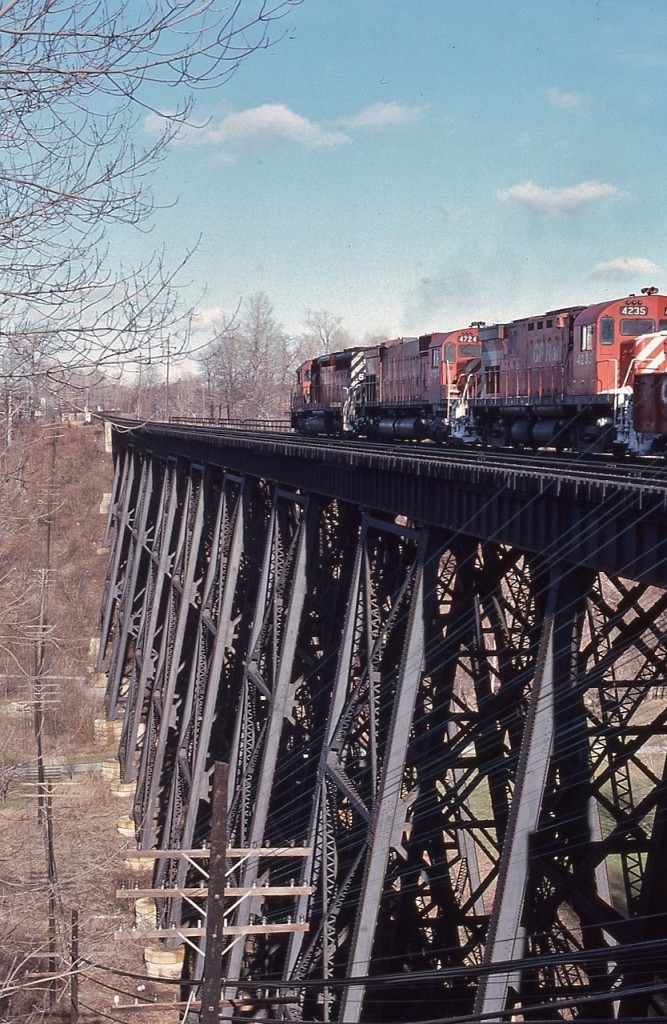|
Caption:
The CPR bridges * over the West Don River ravine - the image demonstrates the challenges of Lake Ontario north shore railway construction.
And yes, bridges, in plural, look closely, the near (north track ) bridge accommodated % the Canadian Northern Railway only access to Leaside where the main CNoR locomotive # and car shops were constructed.
The south track bridge is younger, being a replacement of the original 1884 bridge built by the CPR controlled Ontario & Quebec Railway .
Soaring over the E. T. Seton Park, on approach to the Don Mills crossover a ubiquitous SD40 and two MLW 4726 – 4235 in charge of an eastbound CP Rail, January 12, 1980 Kodachrome by S.Danko.
What's interesting:
* The CPR controlled O & Q Railway survey crews located the new line ( circa1882 ) where the Don River ravines were the narrowest, in the area of the John Lea family farm. First O & Q through train Parkdale to Peterborough June 28, 1884, via West Toronto (Junction) and North Toronto stations (Yonge St). The Don River branch was completed 1893.
% About 1910 the CNoR negotiated the use of the O & Q Railway from the Donlands Junction ( the CN Leaside branch from Duncan (CN Oriole on the CN ( ex CNoR) Bala Sub)) to Wickstead just east of CP Leaside, that 'joint section' included the north track bridge in the image. Today the O & Q is the CPR North Toronto Sub, Belleville Sub (to Agincourt), then the Havelock Sub eastward through Peterborough, Havelock to Glen Tay., The 93 miles east of Havelock pulled up between 1971 and 1988.
# The CNoR was late to the railway scene in the Toronto area. The CNoR required maintenance facilities and the only land available was the area that is now Leaside. In 1912 CNoR purchased 100 acres, had an architect design a 'planned community' then sold off most of the land at a profit. The CNoR proceeded to build the CNoR locomotive shop, a roundhouse and ancillary buildings – all completed circa 1918. In 1917 the CNoR was bankrupt and in the national interest was taken over by the Canadian Government who in 1923 transferred CNoR assets to the newly created CNR. A mere 13 years after completion of the CNoR Leaside facilities, in 1930 the CNR moved most rail maintenance work out of Leaside. The ex CNoR locomotive ( & car ) shop, a 12 railway stall building (92 x 46 meters ), is now commercial space, occupied by a Longo's supermarket. Other evidence of CNoR railway infrastructure is long erased (there were up to 5 large buildings)...however the depressed parking lot on the east side of the former locomotive shop was the site of the CNorR's large transfer table which operated the length ( 92 metres) of the loco shop. The 10 stall roundhouse was located to the south of the loco shop and the main rail yard was east of these facilities. One other CNoR building exists on the south side of Esandar Drive, a small structure that was the CNoR stores building and is now an automobile repair shop.
sdfourty
|


